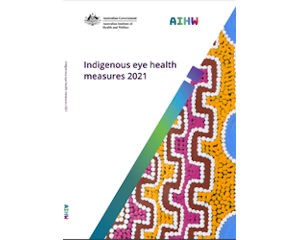Industry News
AIHW Launches Indigenous Eye Health Measures 2021 Report
 Eye diseases and vision problems are the most common long-term health conditions reported by Aboriginal and Torres Strait Islander Australians, with over one-third of Indigenous Australians self-reporting eye or sight problems.
Eye diseases and vision problems are the most common long-term health conditions reported by Aboriginal and Torres Strait Islander Australians, with over one-third of Indigenous Australians self-reporting eye or sight problems.
The Australian Institute for Health and Welfare (AIHW) has launched its Indigenous eye health measures 2021 report that presents data for both Indigenous and non-Indigenous Australians for a range of eye health measures across prevalence, diagnosis and screening, treatment services and workforce and outreach programs. Data are presented over time, by age and sex, by state and territory, remoteness areas and lower level geographies. It shows measurable progress towards improving the eye health of Aboriginal and Torres Strait Islander people. The report includes data from the 2019-20 year, which included the first four months of the COVID-19 pandemic in Australia.
Despite the pandemic’s impact, the report highlights that the number of Aboriginal and Torres Strait Islander people having an eye examination by an optometrist or ophthalmologist continued to grow, reaching 104,300 in 2019-20 (compared to 100,700 in 2018-19).
However, the report also highlights some of the continuing challenges Aboriginal and Torres Strait Islander people face in accessing the eye care they need. For example, Aboriginal and Torres Strait Islander people continue to wait substantially longer for cataract surgery (a median number of 124 days) than other Australians (82 days). There are practical solutions to address these challenges, which are laid out in the national plan for Aboriginal and Torres Strait Islander eye health and vision, Strong eyes, Strong Communities – A five year plan for Aboriginal and Torres Strait Islander eye health and vision, 2019-2024.
Investing in public provision of priority treatments (such as cataract surgery and treatments for diabetic eye disease), supporting development of community led models and building local case management that can help Aboriginal and Torres Strait Islander people connect to, and remain engaged with, treatment are all critical.
Vision 2020 Australia continues to call for Australian Government investment in these and other priority areas so that we can achieve the goal of ending avoidable blindness in Aboriginal and Torres Strait Islander communities by 2025. Vision 2020 Australia Interim CEO Maureen O’Keefe states: “The positive results, despite the impact of the COVID-19 pandemic, demonstrate the progress Vision 2020 Australia members have been making for a number of years in tackling avoidable blindness and ensuring access to timely eye care services for Aboriginal and Torres Strait Islander people. While there is reason for optimism, the AIHW report clearly highlights the need for further work to achieve the goal of ending avoidable blindness by 2025. Now is the time to renew effort and investment in this important area. The eye health and vision care sector has developed Strong eyes, Strong Communities – A five year plan for Aboriginal and Torres Strait Islander eye health and vision to ensure all Australians have the same access to eye care. We are thankful for the support this plan has received so far and are keen to continue working with communities and the government to end avoidable blindness for Aboriginal and Torres Strait Islander people.”



